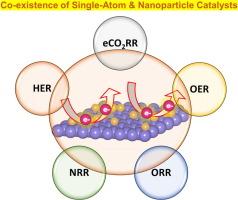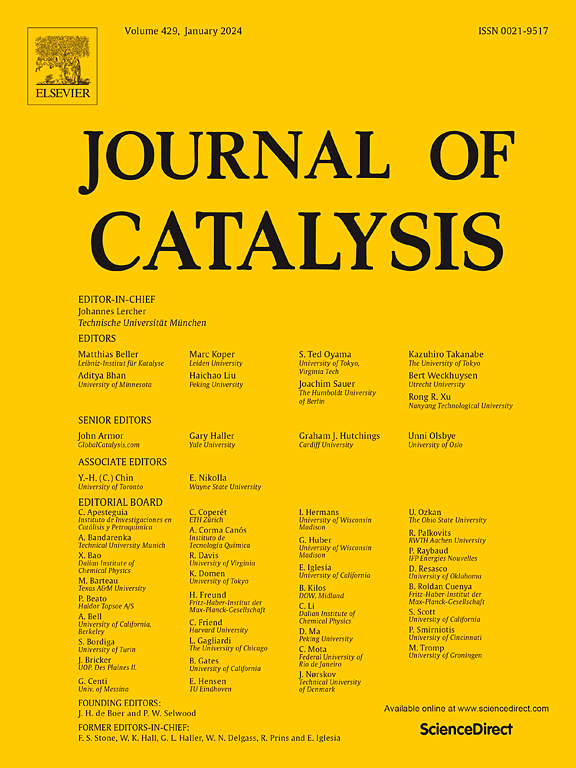Consequences of the co-existence of single-atom and nanoparticle catalysts
IF 6.5
1区 化学
Q2 CHEMISTRY, PHYSICAL
引用次数: 0
Abstract
Single-atom catalysts (SACs) have emerged as promising candidates for electrochemical conversion and storage applications due to their efficient atomic utilization and unique structure, wherein metal atoms are uniformly dispersed and anchored on a support material. This arrangement allows SACs to possess a high density of active sites, maximizing their exposure to reactants and consequently improving reaction rates and selectivity. In light of the growing global demand for renewable and sustainable energy sources, extensive research has been dedicated to designing and fabricating well-defined SAC-based electrocatalysts with optimized electronic structures and diverse compositions over the past decade. Given their exceptional activity and selectivity, particularly for small molecules or key intermediate conversions, the synergistic combination of SACs with nanoparticles (NPs) holds great potential for significantly enhancing performance in complex catalytic processes. In this mini-review, we provide a comprehensive overview of the various possibilities for the co-existence of SACs and nanoparticles, as well as the synthesis and characterization techniques employed in their preparation. Subsequently, we focus on the potential consequences of this co-existence, which has not been extensively explored in the literature, which can lead to improved selectivity towards desire products, thereby boosting the niche applications of these systems. We conclude by emphasizing the major challenges that need to be addressed and highlighting the emerging opportunities in the field of SAC-nanoparticle co-existence systems. By understanding and addressing these challenges, researchers can further advance the development and utilization of hybrid catalyst systems, thereby paving the way for the next generation of efficient and selective catalytic processes.


单原子催化剂(SAC)具有高效的原子利用率和独特的结构,其中金属原子均匀分散并固定在支撑材料上,因此已成为电化学转换和存储应用的理想候选材料。这种排列方式使 SAC 具有高密度的活性位点,最大限度地增加了它们与反应物的接触,从而提高了反应速率和选择性。鉴于全球对可再生和可持续能源的需求日益增长,过去十年来,人们一直致力于设计和制造具有优化电子结构和不同组成的、定义明确的 SAC 型电催化剂。鉴于 SAC 具有优异的活性和选择性,特别是在小分子或关键中间体转化方面,SAC 与纳米颗粒的协同组合在显著提高复杂催化过程的性能方面具有巨大潜力。在这篇微型综述中,我们将全面概述 SAC 与纳米颗粒共存的各种可能性,以及在制备过程中采用的合成和表征技术。随后,我们重点探讨了这种共存的潜在后果(文献中尚未对此进行广泛探讨),这些后果可以提高对有价值产品的选择性,从而促进这些系统的利基应用。最后,我们强调了 SAC 纳米粒子共存系统领域需要应对的主要挑战,并着重指出了新出现的机遇。通过了解和应对这些挑战,研究人员可以进一步推动混合催化剂系统的开发和利用,从而为下一代高效、选择性催化过程铺平道路。
本文章由计算机程序翻译,如有差异,请以英文原文为准。
求助全文
约1分钟内获得全文
求助全文
来源期刊

Journal of Catalysis
工程技术-工程:化工
CiteScore
12.30
自引率
5.50%
发文量
447
审稿时长
31 days
期刊介绍:
The Journal of Catalysis publishes scholarly articles on both heterogeneous and homogeneous catalysis, covering a wide range of chemical transformations. These include various types of catalysis, such as those mediated by photons, plasmons, and electrons. The focus of the studies is to understand the relationship between catalytic function and the underlying chemical properties of surfaces and metal complexes.
The articles in the journal offer innovative concepts and explore the synthesis and kinetics of inorganic solids and homogeneous complexes. Furthermore, they discuss spectroscopic techniques for characterizing catalysts, investigate the interaction of probes and reacting species with catalysts, and employ theoretical methods.
The research presented in the journal should have direct relevance to the field of catalytic processes, addressing either fundamental aspects or applications of catalysis.
 求助内容:
求助内容: 应助结果提醒方式:
应助结果提醒方式:


